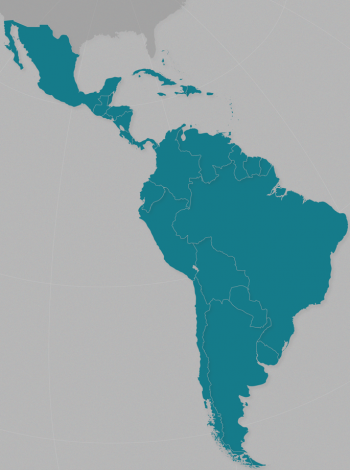Palmares, or Quilombo dos Palmares, was a settlement of fugitive slaves established gradually from the early 1600s to 1694, about 60k inland from the northeast coast of Brazil around the regions of Pernambuco and Alagoas. Estimates indicated that 10,000 to 20,000 fugitive slaves, native Brazilians, and various outcast groups (such as Jews and Muslims) inhabited Palmares throughout the period.
Portuguese colonization, particularly from 1570, brought sugar cane plantations to the northeast coast of Brazil, utilizing, as labor, enslaved Africans and native peoples. Some of the slaves and native Americans resisted and established small settlements or quilombos in the area of Pernambuco, where palm trees abounded (thus the name Palmares).
Illustrative of its complexity, Quilombo dos Palmares in 1640 was described as comprising several separate settlements which pledged their loyalty to one leader (chief). Two of the settlements were mostly of Indigenous origin (Subupira e Tabocas); one of the Portuguese colonists who joined the quilombo (Amaro), and seven Bantos, that is, settlements of fugitive slaves (Andalaquituche, Macaco, Aqualtene, Ambrabanga, Tabocas, Zumbi, Arotiene). With its capital in Macaco, Palmares possessed a complex social structure, replicating, in many instances, African political systems.
When the Portuguese lost control of the region to the Dutch in the 1630s, the new colonial rulers continued the military campaign of the earlier Portuguese to bring Palmares under control. They were no more successful than their predecessors, and the quilombo continued to grow. In 1654, when Portugal regained control of the area, it resumed its attempts to conquer Palmares.
Portuguese military forces and mill owners in the region attempted to regain control over the quilombo for the next forty years. Ganga-Zumba, the Palmares chief during the latter part of this period, tried to negotiate an agreement with the Portuguese where the quilombo would no longer accept fugitive slaves or fight the Portuguese in exchange for permanent recognition of their land and freedom for those born in Palmares. However, Zumbi, the settlement’s military leader, chose resistance to the Portuguese. The Portuguese never accepted Ganga-Zumbi’s proposal and continued to attack the quilombo. Finally, in 1694, Palmares was conquered and destroyed by a military force under the command of Domingos Jorge Velho. Zumbi was killed one year later in 1695.
Palmares was a multifaceted quasi-state that lasted for most of the 17th Century, resisting attack by two European powers. Known for challenging Dutch and Portuguese sovereignty in Brazil, Palmares was a symbol of resistance to colonialism and the possibility of multicultural coexistence.
However, the destruction of Palmares failed to stem the emergence of hundreds, perhaps thousands of smaller quilombos throughout Brazil. Nor did it prevent countless other acts of resistance that undermined planter domination even after the abolition of slavery in 1888. Cheney describes how the legend of the Quilombo dos Palmares inspired a 1988 constitutional amendment that extended land rights to the descendants of fugitive slaves. Thousands of “modern quilombos” have petitioned for government recognition while organizing mass movement in the countryside that has won concessions from local landowners and pressured elected officials to implement affirmative action policies in other areas. In 2015, the specter of Palmares looms large over Brazil.
Megathreads and spaces to hang out:
- ❤️ Come listen to music and Watch movies with your fellow Hexbears nerd, in Cy.tube
- 💖 Come talk in the New Weekly Queer thread
- 💛 Read and talk about a current topics in the News Megathread
- 💚 Come and talk in the Daily Bloomer Thread
- ⭐️ September Movie Nominations ⭐️
reminders:
- 💚 You nerds can join specific comms to see posts about all sorts of topics
- 💙 Hexbear’s algorithm prioritizes comments over upbears
- 💜 Sorting by new you nerd
- 🌈 If you ever want to make your own megathread, you can reserve a spot here nerd
- 🐶 Join the unofficial Hexbear-adjacent Mastodon instance toots.matapacos.dog
Links To Resources (Aid and Theory):
Aid:
Theory:


Can anyone recommend YouTube channels to me?
I’m looking for more long form gaming content. I’d also be interested in history if you know of something entertaining.
Nothing overtly political or music please.
Been enjoying Majuular lately, he just put out a video on the development of Ultima
Been watching him too but i watched him freak out and ban a commenter on one of his streams which made me feel different about him. Still gonna watch his stuff but no streams anymore
Fair, I’ve never watched one of his streams so I don’t know what his conduct is like outside of the video essay stuff
Matthewmatosis video essays. Retro Pals streams. Lambhoot video essays. Transparency video essays. Sean Seanson talking about PS1 games for 2-3 hours at a time. Chrontendo talking about NES games for 30-50 minutes at a time. Errant Signal video essays. Amelie Doree review/essays on Japanese visual novels we didn’t get. Phlying Phalanges on weird comedy rants on video games. Displaced Gamers on enjoyably explaining NES code and video game mechanics in a way non-programmers might understand and care about. PandaMonium on these really well-researched video essays on the production and context of US-released Sega Saturn games.
For longform gaming content do you want analytical deepdives, general gaming discussion in podcast format, or let’s play style stuff?
Anything good basically
Probably subbed already, but I think digital foundry are perfect for anythkng news related and tech reviews.
If you like stratrgy games (and especially civ vi) potatomcwhiskey is good.
Melee documentaries maybe?
This is the big one and the YouTube recommendations will then take you to the hundreds of other smaller and more specific ones
https://youtu.be/jX9hbbA-WP4?si=iH8h8KC8vNqq8Brv
I found a YouTube link in your comment. Here are links to the same video on alternative frontends that protect your privacy:
Zulie the Witch will tell you everything about Dark Souls and related games in agonizing detail over the course of several days.